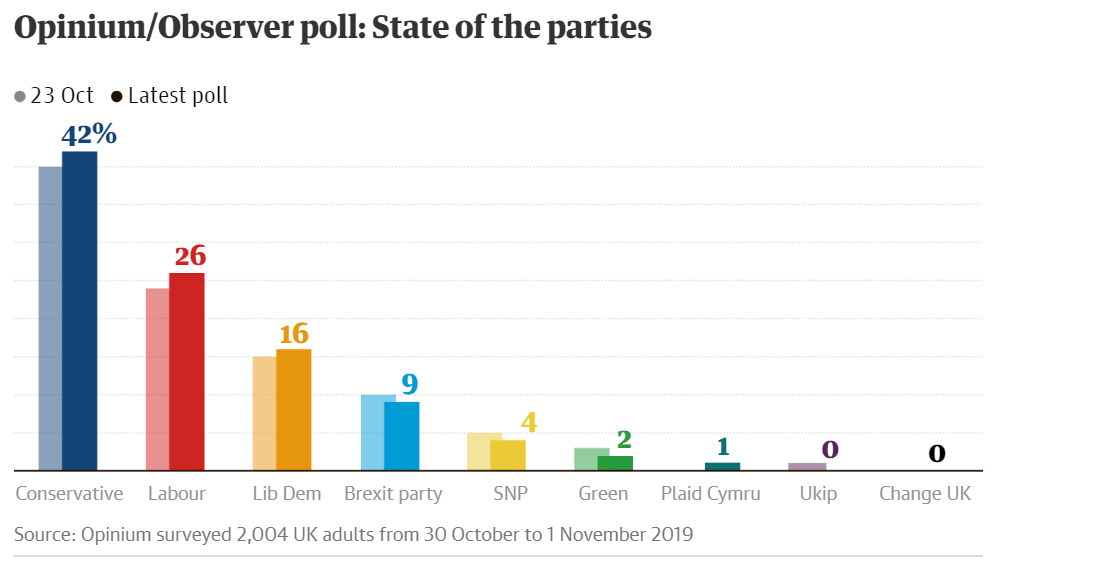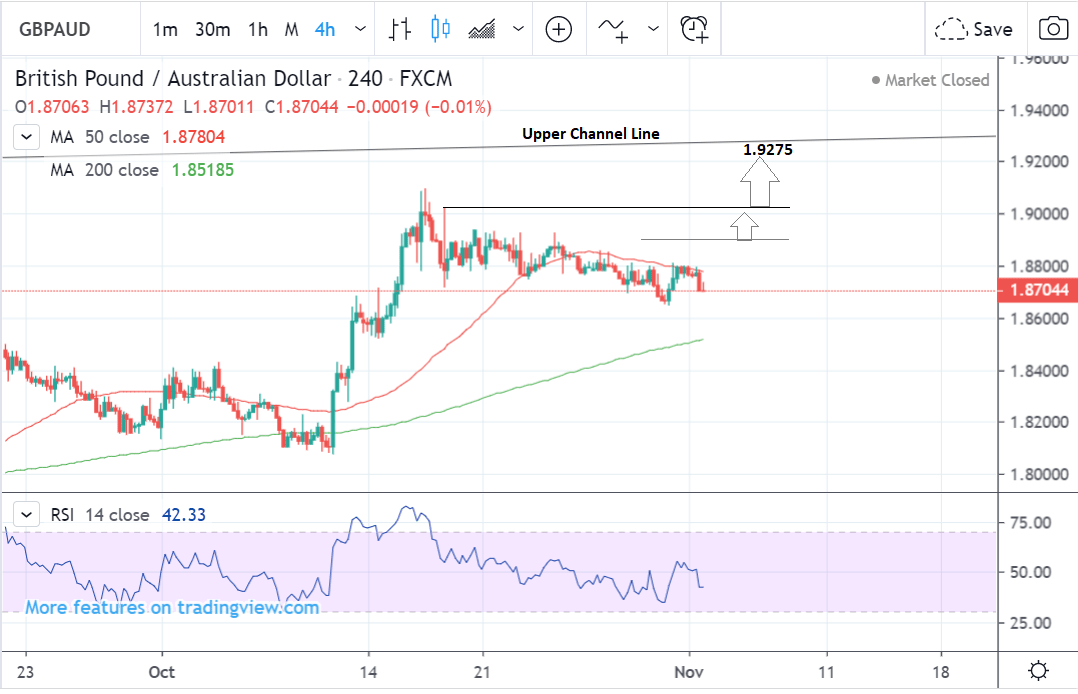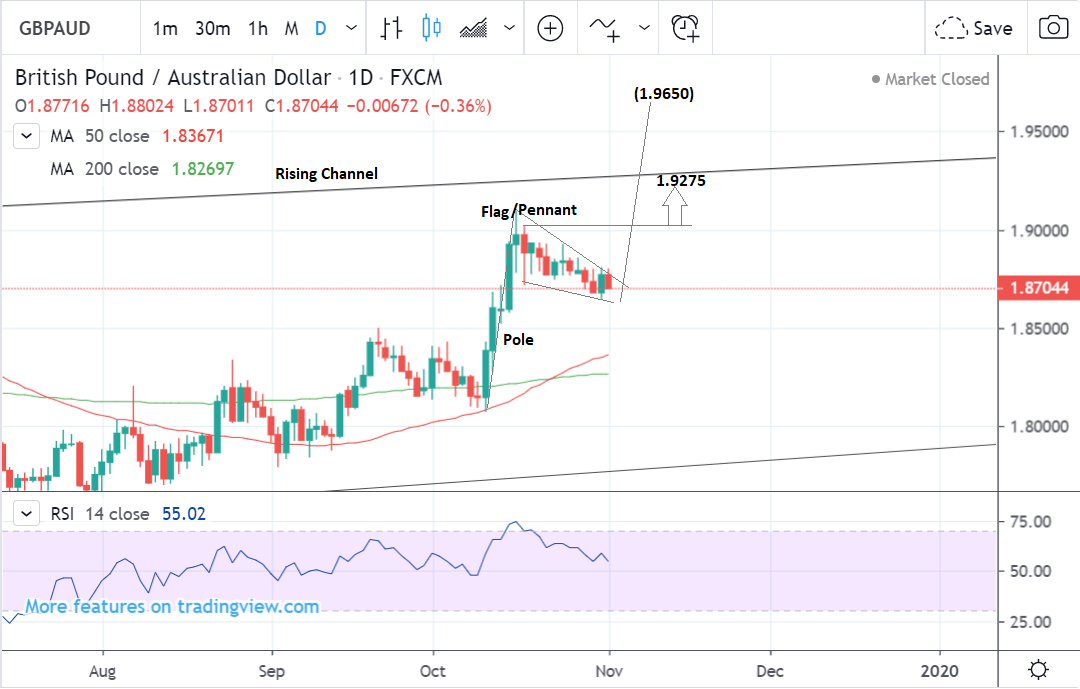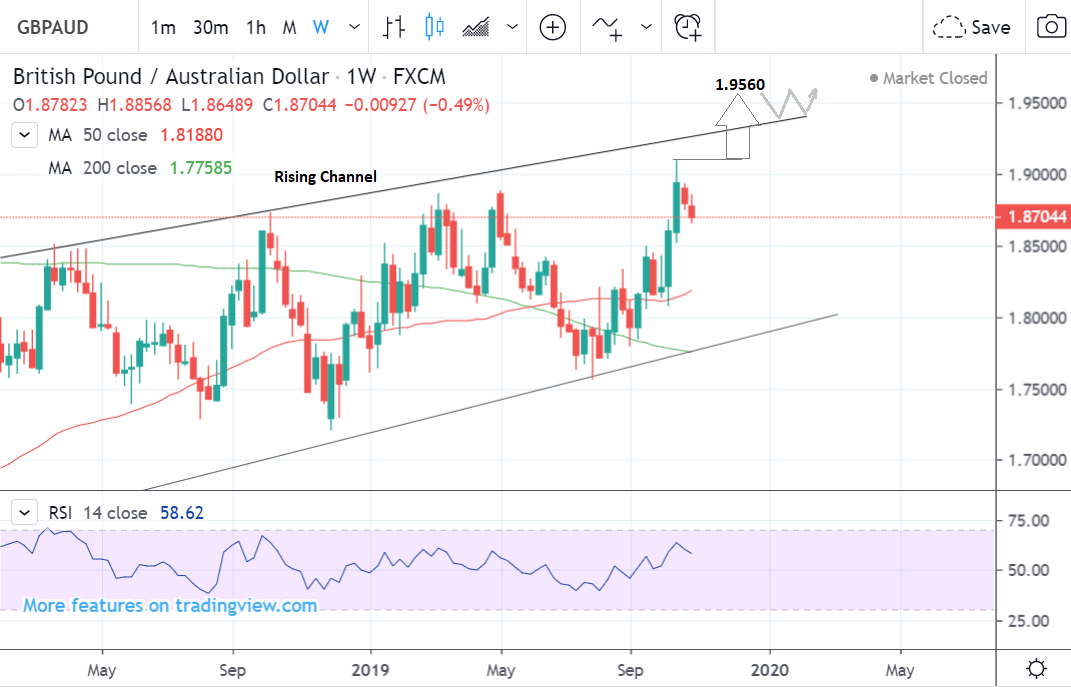Pound-Australian Dollar Week Ahead Forecast: Bullish Continuation Pattern Advocates for Gains

Image © Adobe Images
- GBP/AUD has formed a bull flag with an upside bias
- Sterling driven by opinion polls and BOE meeting
- Aussie to be driven by RBA meeting analysis
The Pound-to-Australian Dollar exchange rate is trading at around 1.8704 at the start of the new week after falling -0.50% in the week before. The exchange rate is steadily pulling back after rallying but the ‘look and feel’ of the charts marginally favours an eventual bullish continuation once the correction ends.
The 4 hour chart - used to determine the short-term outlook, which includes the coming week or next 5 days - shows how the pair has been pulling back down steadily after peaking at the October 16 highs.
The correction is relatively shallow and comes after a very steep rally. This suggests a relatively good chance the pair will resume its uptrend once the pull-back ends.
A break above 1.8900 would provide initial confirmation that the uptrend was resuming, but a break above 1.9020 would provide stronger confirmation.
If the pair does resume its uptrend it will probably rise up to a target at the upper channel line, at 1.9275, initially.
The daily chart shows how the pair has probably formed a flag or pennant pattern which is a bullish continuation pattern.
It suggests there will probably be a breakout higher to a target - first at the upper rising channel line and then eventually at around 1.9650.
Bull flags are composed of a ‘pole’ section which is a steep rally, and then the actual flag square or pennant part made up of sideways consolidation.
When they breakout higher they usually extend as far up as the length of the ‘pole’ extrapolated higher, which in this case gives a target at around 1.9650.
A break above the channel line would be necessary to confirm such a continuation, confirmed by a move above 1.9300.
The daily chart is used to give us an indication of the outlook for the medium-term, defined as the next week to a month ahead.
The weekly chart shows the bigger picture of the rising channel which began at the 2017 lows.
The most recent move up within the channel has been quite steep and there is a possibility that it could breakout and go even higher, however, if this were to happen it would risk being an ‘exhaustion move’.
Exhaustion moves tend to occur when prises accelerate and break out of the top of rising channels (or bottom of falling channels).
They normally mark the end of the trend, suggesting that if GBP/AUD was to break out of the channel higher it could be a sign of exhaustion and a bearish indicator.
In any case, it would probably be unable to sustain such a steep climb for long and would be likely to pause, at the very least, once the 1.9650 ‘flag’ target has been reached.
The weekly chart is used to give us an idea of the longer-term outlook, which includes the next few months.
Time to move your money? Get 3-5% more currency than your bank would offer by using the services of a specialist foreign exchange specialist. A payments provider can deliver you an exchange rate closer to the real market rate than your bank would, thereby saving you substantial quantities of currency. Find out more here.
* Advertisement
The Australian Dollar: What to Watch

The main event for the Australian Dollar in the week ahead is the policy meeting of the Reserve Bank of Australia (RBA), which ends on Tuesday at 3.30 BST.
The RBA cut interest rates by 0.25% at their meeting in October, however, they are not expected to cut interest rates any lower in November, which is good news for the Aussie Dollar.
“The RBA is expected to hold rates in November. In fact, following the October cut the RBA has been signaling that it is not in a rush to cut interest rates again,” says Raffi Boyadijian, senior analyst at FX broker XM.com.
A cut in interest rates would be negative for the Aussie as it will reduce net foreign capital inflows since foreign investors tend to prefer placing their money where interest is higher and it will accrue higher returns.
In regards to the meeting, investors will be more interested in the question of whether or not this would constitute a temporary pause or a more permanent one, and they will be looking at the statement and economic forecasts for clues.
There is still a material risk of the RBA will cut interest rates in the future.
“Although we have seen rate cut expectations fall following the announcement of that Phase 1 trade deal with China, inflation in Australia is still very low so further rate cuts might still be needed,” says Boyadijian. “If the RBA is downbeat about the economic outlook, that would be signal that they will have left the door wide open for further cuts for this year and then next year, and that could eventually hurt the Australian Dollar.”
The Pound: Watching the Polls and Bank of England

The main event for the Pound in the week ahead will probably be the Bank of England (BOE) meeting on Thursday, Services PMI data on Tuesday, and the results of opinion polls in the run-up to the December general election.
The BOE is not expected to announce a change in policy or interest rate settings when it ends its meeting at 12.00 BST on Thursday, but there is growing speculation the accompanying statement from the bank may hint at a shift to a more neutral stance due to weaker growth.
“There is a lot of speculation that the BOE will finally give up its tightening bias at its next meeting, and although they are unlikely to signal an easing bias they will probably adopt a more neutral stance, because it is not just Brexit that is weighing on the UK economy we also have the global slowdown, and the UK economy is struggling as a result,” says Raffi Boyadijian, senior investment analyst at FX broker XM.com
The key data release of the coming week is October Services PMI which is forecast to show a slight rise to 49.7 from 49.5 when it is released on Tuesday at 9.30 BST.
Recent Manufacturing PMI for October was better-than-expected but analysts dismissed the result as caused by one-off factors due to stockpiling ahead of the October 31 Brexit deadline.
It may be that Services, therefore, can provide a more accurate gauge of activity in the economy in October since it would probably not be subject to the same ‘stockpiling’ bias as manufacturing.
A higher than expected reading should be taken as positive or bullish for Sterling, while a lower than expected reading should be taken as negative or bearish for the Pound.
Financial markets now see opinion polls as the main barometer to watch in terms of gauging Brexit outcomes which means any major swings in polls could impact on Sterling.
The latest opinion poll in the Observer shows Boris Johnson’s Conservatives in a comfortable 16 point lead on 42%, Labour lagging on 26%, the Brexit party seeing their vote shrink to only 9.%, whilst the Liberal Democrats are on 16%.
The larger the Conservative lead, the better for the Pound, as it suggests Johnson will win with a comfortable majority and can pass his deal unimpeded.
How these percentages translate into actual seats, however, is more difficult to forecast. This is due to the ‘first past the post’ electoral system used in the UK in which MP’s fight over seats individually rather than gaining a representative share of the broad national vote.

Time to move your money? Get 3-5% more currency than your bank would offer by using the services of a specialist foreign exchange specialist. A payments provider can deliver you an exchange rate closer to the real market rate than your bank would, thereby saving you substantial quantities of currency. Find out more here.
* Advertisement







